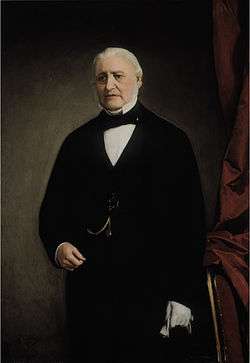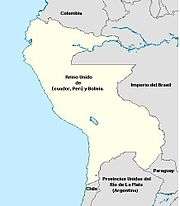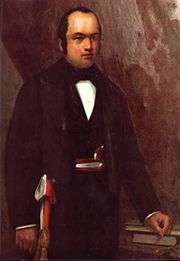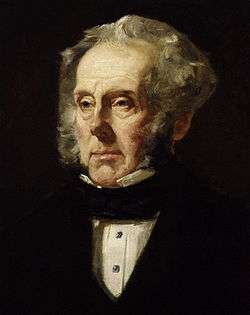Attempted Spanish reconquest of Ecuador
The attempted Spanish reconquest of Ecuador was a project organized in 1846 by Juan José Flores, deposed president of Ecuador, and the Spanish queen mother Maria Christina of the Two Sicilies, to recover the former colony of the Royal Audience of Quito, and establish there a monarchy chaired by one of the sons of the Queen. The plan included also expand the territory to the south, absorbing the republics of Perú and Bolivia to conform the United Kingdom of Ecuador, Perú and Bolivia.
Although most of the diplomatic documents points as a presumptive nominee to King of Ecuador to Agustín Muñoz of Bourbon-Two Sicilies, child of the second marriage of Maria Christina with the Duke of Riánsares. There are others in which it is assumed that the king Louis Philippe I of the French could also have been involved in the project, contributing with his own money like Maria Christina, to place in the South American throne the children of both who just get married at the time: Antoine D'Orleans and Luisa Fernanda of Bourbon.[1] However, the French government rejected any deals and did not support any Spanish reconquest of Ecuador.[2]
Background

During the first decades of the new and fragile Ecuadorian nation, General Juan José Flores, overthrown from the presidency by the people of Guayaquil after 14 years in power, convinced himself of the ungovernability of the country under a republican regime, where discord between the new powers was evident. He thought that only a dictatorship under his own control, or a foreign protectorate with a European prince, could rescue Ecuador from chaos. According to Mark Van Aken, US historian and biographer of Flores: "to make this affirmations are available the usual historical sources: governmental documents, official and independent journals, pamphlets and particular correspondence".[3]
Treaty of La Virginia
As president of Ecuador, Flores surrounded himself with many Venezuelan advisors and militaries, causing a national backlash by the Ecuadorian elites who wanted access to those important government positions. This triggered a civil war initiated with the Chihuahua's War and culminated with the March Revolution, cored in the city of Guayaquil and led by Vicente Rocafuerte, famous writer and diplomat who was then exiled in Lima. The first constitutional president of Ecuador was finally overthrown in June 17, 1845, when he capitulated from his property named La Virginia Estate.[4]
A few days after signed the Treaty of La Virginia, which peacefully deposed Flores and guarantee his military status, the conservation of his properties and a lifetime income of 20,000 pesos, the ex president part to his agreed European exile. On August 10, the US agent Delazon Swith reported that via a close relative, Flores had smuggled more than 40,000 dollars cash, jewelry, diamonds, and a hundred pounds of silver in bars across the southern border. As a result, the National Convention of Cuenca ignored the treaty, refusing to recognize the rights of Flores and his supporters.[5]
To Ecuadorian politician Benigno Malo: "that resolution, far from close the doors to his comeback, only served to tempt him to adopt retaliations of extreme and immoral nature (...) Flores, taunted, felt fully authorized to follow the advice of revenge. He was cheating himself, one crime do not washes with another".[6]
The monarchist project


After hear the news of the decision of the new ecuadorian government breaking the terms of the Treaty of La Virginia, the ex president Flores gets angry and organize from Europe one of the most bolder plans of the latinamerican warlordism to reconquer the power of the country. He contacted his friend and former mate of independence struggles, the Irish general Richard Wright who was in England, and entrusted him the task of recruiting 1200 men, get enough weapons and acquire three warships to proceed with the invasion to Ecuador. Immediately, Flores went to France and tried to get more support to his invasion, even proposing the conversion of the South American country into a monarchy with a European prince, with himself as a regent.[4]
Flores arrives to Paris, where three of his sons was studying, and is awarded with the cord of the Legion of Honour by the king Louis Philippe I. In the Court, the general asks for weapons and soldiers for his daring venture, but there were denied officially by the government. From there he went to the Vatican, when met with the secretary of the Papal States and receives the blessing of the pope Gregory XVI. Finally, after request for the recommendation letters he needed in the Kingdom of the Two Sicilies, he headed to Spain.
The general came to Madrid with his monarchial proposal before the former queen Maria Christina of the Two Sicilies, who was regent of her daughter Isabel II between 1833 and 1840, and continued exerting influence in the Spanish government after a period exiled from the Court (1840–1844). The Queen convinced the Cabinet, headed by Francisco Javier de Istúriz, to secretly host the plans of the ecuadorian ex president. The wish of Maria Chritina was to place in American thrones her children with the Duke of Riánsares, and even is accurated the name and age of the child: Agustín Muñoz of Bourbon-Two Sicilies, who was 13 years old, studied in Rome, and had the titles of Duke of Tarancón, Earl of San Agustín and Viscount of Rostrollano.[6]
Maria Christina financed Juan José Flores with her own personal fortune, made with the successful businesses of the Duke of Riánsares. She also got a loan of one and a half million of duros gave by the bankers Seriola, Carriquí, Salamanca and Buchental. The loan was fixed at a rate of 7% annual interest, payable by semesters with all the rents of Ecuador.[5]
Meanwhile, in England and Ireland, General Wright had acquired three ships: Neptune, Monarch and Glenelg.[5] Two of this steamships were transformed in warships, while the third was intended for the transport of supplies and troops. He also had amassed so far two battalions of 400 men each one (from a total planned of 1200). The Irish, whose homeland was ravaged by the Great Famine, had been engaged with the promise of lands and farm implements to colonize the provinces of Napo and Esmeraldas.[7]
The Spanish government supported the expedition secretly, so their met smoothly 1500 men in the port of Santander, since not be faced with revolts or wars could part with some military personnel. On the other hand, Great Britain pretends not to know the preparations, while the Irish authorities opposed from the beginning.[8]
United Kingdom of Ecuador, Perú and Bolivia

Ángel de Saavedra, the Duke of Rivas, who was the Spanish ambassador to the Court of the Kingdom of the Two Sicilies, heard in Naples the Flores's plans to put a Spanish prince in the throne of a tentative Kingdom of Ecuador. But, for his surprise, the chieftain idea doesn't stops there, because under the protectorate of Spain the said prince must seeks to expand geographically the territory to the south, at the expense of the neighbors of the initial small state.[6]
It means the attempt included mainly to Perú and Bolivia, to thereby form a federate state of three kingdoms, following the example of England and Scotland unified in the United Kingdom of Great Britain, or the partner crowns in the Austro-Hungarian Empire. This intention of South American monarchy its called United Kingdom of Ecuador, Perú and Bolivia, which is planned by Flores, would have its throne in the city of Quito and the monarch would be the mentioned Agustín Muñoz of Bourbon-Two Sicilies, who was called by the Queen as Prince of Ecuador and Restorer of the monarchy in Perú and Bolivia.[4]
The alleged French involvement

There are several documents, mostly diplomatic correspondence between Latin American embassies settled in London, in which the personal participation of the French monarch Louis Philippe I is presumed, because the Government officially denied the support to Flores when he was in Paris before. For this, the King bring his own money in exchange for placing one of his descendants in the ecuadorian throne. [9][10]
According to Francisco Michelena Rojas, Ecuador's ambassador in London, the plans to create a Kingdom of Ecuador traced by Flores would have been echoed in the major European Courts with interests in America. Michelena mainly accused France of stirring in different ways to establish its domination, offering their princes under family alliances, or their protectorate, trying to influence governments against national interests and humiliating their novel nationalities. For this, the money needed for the expedtition probably coming from the king Louis Philipe I.[6]
In the other hand Manuel Moreno, Argentina's ambassador in London, also suspected the French intervention in Ecuador, believing that the candidacy to the throne offered to Agustín Muñoz of Bourbon-Two Sicilies was only apparent and provisional, and that basically everything was run by the French monarch to end with the other part of the Treaty of Utrecht, bringing the House of Orléans to Latin America. MOreno based his hypothesis on the strategic marriage between the French prince Antoine and the Spanish infanta Luisa Fernanda, daughter of Maria Christina in her first marriage with the king Fernando VII, for whose benefit would actually be the future monarchy their pretend to set up in America from Ecuador.[6][1]
Latin American reaction
The plans for the journey to America and retake power in Ecuador seemed quite ready; however, several Latin American diplomats in European courts began to hear about the Bourbon expedition, although they were initially unsure it was bound for Mexico, Bolivia, Ecuador or Peru. This is evidenced by a letter from M.A. Mosquera, neogranadine minister in Paris, sent on August 15 of 1846 to his Foreign Ministry in Bogota, and then will be transmitted by it to Buenos Aires. In it, Mosquera explains "every reason to believe it rather to Mexico, acting as assistant to hold the monarchist party of that country; and resist aggression and successive encroachments of the United States".[11]
One of the first to warn that the fate of the Spanish and British troops was definitely Ecuador, was the Peruvian minister Juan Manuel Iturregui, accredited at the Court of London. On September 16 he wrote to the Foreign Ministry in Lima the following:
General Flores is organized in Madrid a few battalions which should form the basis of an expedition preparing ostensibly against Ecuador. The newspapers of that capital announced the expedition also threatens Peru and comes from an agreement made between the Spanish government and that General to invade both Republics and train them a monarchy, headed by one of the two children born from Maria Christina of Bourbon in her second marriage with the Duke of Rianzares. The Spanish Cabinet visibly protects this company, and are pulling chiefs, officers and hundreds of soldiers from the peninsular army to incorporate what is raising the general Flores. Agents are engaging soldiers of Ireland to join the ranks of the expedition, and so everyone is ready and summoned to meet in Aspeitia, where will sail to America.[6]
The news was reinforced in September 30, when Argentine minister M. Sarraeta, accredited at the court of Paris, writes from Brussels to his Foreign Ministry:
A shocking event and the most serious is currently happening in Spain. The ex-President Flores of Ecuador, who had to abdicate and retire from command as your excelence know, is recruiting in Spain with knowledge and coexistence of that Government, a force that says no lower than six thousand men destined to regain his lost authority, invading its former presidency. Whoever happens in business of this nature, Flores can not be more than a figurehead, which is instrumental in promoting the interests of who provides the means for the company. Flores was very well received by the King in Paris and has been in Spain, where he gained the dubious distinction of dance with the Queen. Everything conspires to persuade the plan currently running in Spain is organized in France and there is still very plausible, either with knowledge and acquiescence of England. When I left Paris it was announced as positive the arrival of general Santa Cruz to one of the ports of France; then there has returned to talk it over, nor was appeared in Paris, as it's natural. This circumstance made me suspect he had gotten in Spain, I wrote asking for reports on the matter and so far I have not received a reply.[11]
Juan Manuel Iturregui directed two protests without waiting instructions from Lima; one of them was made to the Spanish Minister of Foreign Business, and the other to Lord Palmerston, the British Secretary of State for Foreign Affairs. The Spanish government's response was that Iturregui, despite being official delegate, had never been proven in Court; while Palmerston, in evasiveness, claimed no knowledge of illegal enlistments for foreign countries.[8]
Iturregui insisted again with his request to Palmerston, claiming that general Flores had already gathered 1200 men in Ireland; explained that such hostile force, but ultimately failed, affecting British commercial interests in Latin America. Palmerston was irritated further allusion to possible damage to British interests and replied: "the british Government will very much welcome a change whereby the behavior of the governments of those countries (the southamerican republics) to british citizens, were more in keeping with the law, good faith and treaty obligations".[8]

On November 9, 1846, Peruvian Foreign Minister José Gregorio Paz-Soldán y Ureta, officially advised the Latin American foreign ministries determination of his Government to defend the ecuadorian independence, and called on them to cooperate in this crusade:
(...) without bound your votes and efforts with those of all peoples of America to hold the common identity of independence and principles and institucions that were adopted since shook the ominous Spanish yoke. In the rights of Ecuador, outraged by the Spain, Peru has received an insult, because it feels like own the wrongs done to the peoples of the Americas, and as a violation of natural justice and the law of nations as soon as it is done by whoever it in order to fix the internal affairs of a free people of South America'.[11]
For its part, the Chilean Foreign Ministry, after learning that general Andrés de Santa Cruz is located in Europe as reported by the Argentine foreign minister from Brussels, and fearing that the expedition has meant to revive the Peru-Bolivian Confederation, wrote to his counterpart Argentina's letter dated December 1, 1846:
(...) and that the Spanish Government had any interest in it as the conduct followed, that would otherwise be completely unexplained. It is also quite likely that suspicious generals Flores and Santa Cruz are united in the company and question raised, in one form or another, perhaps the monarchy, the former Peru-Bolivian Confederation. (...) the Government of Chile has believed that the matter was too momentous importance, lest after orders were taken from all hazards, and has no basis to believe that their neighbors share the same application and are determined to cooperate'.[11]
On December 29, 1846, José Fernández Salvador, Minister of Foreign Affairs of Ecuador wrote to his venezuelan counterpart about the monarchical project:
(...) as it seems unlikely that the designs of the Spanish expedition only limited to reset the command of Ecuador to the leader who directs it, according to the generally issued by the european press, the governments of Chile, Peru and New Granada, have believed that any act of transatlantic intervention is prejudicial to the independence of the Latin American states, or at least to representative popular form of their governments, and therefore interested in American politics common agreement to repel any force who attempts to intervene in the domestic affairs of any of those Republics.[11]
Fall of the project
On October 20, 1846, the increasingly growing opposition from the British public opinion, who joined the efforts of the Latin American delegations in that country, intensified with the formal protest over thirty commercial houses that saw a threat to British economic interests in the project of the general Flores, as had been raised before by the Peruvian Minister Iturregui. This forces the chancellor Palmerston, invoking the Law on Foreign Recruitment, to confiscate the ships of Flores by officials of the Custom House. Similarly filed a lawsuit against those responsible for the company, while alongside the mayor of Limerick (Ireland) took over to stop the recruitment took place in that locality.[8]
This situation forced Flores, who was in the Court of Madrid, to come to England to defend himself and get back their ships, but at the prospect of being involved in the trial, he tried to return to Spain by Paris. But the bad news did not end for Flores, as in Spain, José Joaquín de Osma published the news of the embargo in the newspapers of the iberian capital that, joined other reasons, forced the Cabinet of Francisco Javier de Istúriz, to resign. The new government, led by the VIII duke consort of Sotomayor, reversed the tank of soldiers who were ready for the attempt in Santander.[8]
Flores spent several months in Europe, vainly trying to regain their ships with the support of queen Maria Christina, who wanted to recoup some of her investment, and so was the center of unrest and revolt against Ecuador during the next decade. This allowed the first ecuadorian president to be recognized for his brilliant, yet dark qualities, as the "King of the Night".[8]
References
- 1 2 Cervera, César (May 19, 2015). "María Luisa Fernanda of Bourbon, the daughter of Fernando VII who wanted to reign in Ecuador and almost did in Spain" (in Spanish). Madrid. ABC.es. Retrieved July 11, 2015.
- ↑ Mark J. Van Aken (1989). King of the Night: Juan José Flores and Ecuador, 1824-1864. University of California Press. p. 180.
- ↑ Paris Montesinos, Pedro. "Monarchists outbreaks in the 19th century". El Universal Newspaper. January 3, 1997. Retrieved April 17, 2015.
- 1 2 3 Van Aken, Mark (1989). King of the night, Juan José Flores & Ecuador 1824-1864. United States: University of California Press. Retrieved April 17, 2015.
- 1 2 3 Péres Pimentel, Rodolfo. "Juan José Flores y Aramburu". Ecuadorian biographical dictionary, vol X. Universidad Católica Santiago de Guayaquil. Retrieved April 17, 2015.
- 1 2 3 4 5 6 Orrego Penagos, Juan Luis. "The general Juan José Flores and Perú". Rumbo al Bicentenario. December 2003. Retrieved April 17, 2015.
- ↑ McEvoy, Gabriella (2013). The value of the files in the invisible Irish (PDF). United States: Irish Migration Studies in Latin America. Retrieved April 17, 2015.
- 1 2 3 4 5 6 Garibaldi de Mendoza, Rosa (June 28, 2009). "When Ecuador almost became a Kingdom". El Comercio of Perú Newspaper. Retrieved April 17, 2015.
- ↑ Vélez Ochoa, Ricardo (2006). The shipwrecked species (in Spanish). Bogotá: Javerian Pontifical University. p. 146.
- ↑ Van Aken, Mark. King of the Night: Juan José Flores and Ecuador 1824-1864. United States: University of California Press. p. 216. Retrieved April 18, 2015.
- 1 2 3 4 5 Castillo Illingworth, José Santiago. "The american monarchy project (part 3)". Genealogía familiar. Retrieved April 17, 2015.
External links
| Wikimedia Commons has media related to Spanish reconquest attempt in Ecuador. |
